wp1
Conference papers accepted: EUSFLAT
01/09/23/12:17 Filed in: Conference papers
T. Flaminio, Ll. Godo, N. Madrid, M. Ojeda-Aciego. A Logic to Reason About f-Indices of Inclusion over Ł𝑛. Proc. of EUSFLAT 2023.
ABSTRACT In this paper we provide a sound and complete logic to formalise and reason about f-indices of inclusion. The logic is based on finite-valued Lukasiewicz logic and its S5-like modal extension S5(L) with additional unary operators.
Published in Lecture Notes in Computer Science, vol 14069: 530-539, 2023.
M. Ojeda-Hernández, P. Cordero, I.P. Cabrera, E. Muñoz-Velasco. Closure structures as fixed points of some Galois connections. Proc. of EUSFLAT 2023.
Extended abstract published in Book of Abstracts EUSFLAT 2023.
PhD thesis
24/10/23/10:01 Filed in: PhD thesis
M. Ojeda-Hernández. Fuzzy closure structures and quasi-closed elements on fuzzy complete lattices. PhD thesis, 2023.
A very good dissertation (Summa Cum Laude) by Manuel on an important topic of our work package on Foundations.
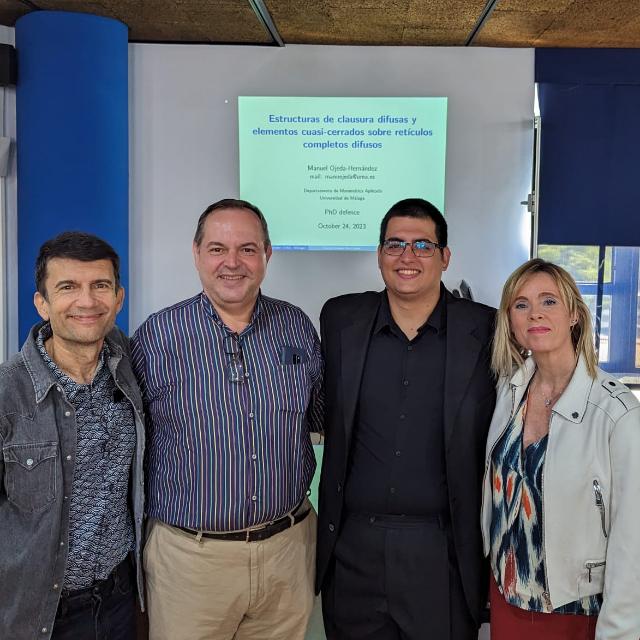
Conference papers accepted: ICCS
01/09/23/12:17 Filed in: Conference papers
C. Bejines, D. López-Rodríguez, M. Ojeda-Hernández. Aggregation Functions and Extent Structure Preservation in Formal Concept Analysis. Proc. of Int. Conf. on Conceptual Structures.
ABSTRACT Formal Concept Analysis (FCA) is a mathematical framework for analysing data tables that capture the relationship between objects and attributes. The concept lattice derived from such a table is a representation of the implicit knowledge about this relationship, where each concept corresponds to a bicluster of objects and attributes. FCA has been widely used for knowledge acquisition and representation, conceptual data analysis, information retrieval and other applications. In this paper, we use an extension of the classical FCA to deal with fuzzy formal contexts, where the relationship between objects and attributes is modelled by truth values indicating the degree to which an object possesses a property or attribute. Fuzzy Formal Concept Analysis (FFCA) allows us to capture vague or imprecise information and handle uncertainty or ambiguity in data analysis. Our purpose is to use aggregation functions in order to manipulate and explore fuzzy formal concepts in different ways depending on the desired properties or criteria. In this work, we will focus on the structure of the extents of the concept lattice. We define the aggregation of fuzzy extents point-wise and study how it affects its structure. We characterise the aggregation functions that preserve the fuzzy extent structure and show that they depend on the number of objects in the context. Our results contribute to a better understanding of how aggregation functions can be used to manipulate and explore fuzzy formal concepts..
Published as Lecture Notes in Computer Science, vol 14133: 28-35, 2023
M. Ojeda-Hernández, I. P. Cabrera, P. Cordero, E. Muñoz-Velasco. On Pseudointents in Fuzzy Formal Concept Analysis. Proc. of Int. Conf. on Conceptual Structures.
ABSTRACT Formal Concept Analysis (FCA) is a mathematical framework for analysing data tables that capture the relationship between objects and attributes. FCA deals with two main structures of knowledge, namely the concept lattice and the basis of attribute implications. There are several sets of implications in the literature, for instance minimal bases, direct bases or direct minimal bases. In this work we are interested in the concept of pseudointent in the fuzzy framework in order to define the Duquenne-Guigues basis in the fuzzy setting.
Published as Lecture Notes in Computer Science, vol 14133: 36-40, 2023
Journal paper accepted: INS, KYB
01/09/23/12:17 Filed in: Journal papers
O. Krídlo, D. López-Rodríguez, L. Antoni, P. Eliaš, S. Krajči, and M. Ojeda-Aciego. Connecting concept lattices with bonds induced by external information. Information Sciences, 648:Article 119498, 2023.
ABSTRACT In Formal Concept Analysis (FCA), L-bonds represent relationships between L-formal contexts. Choosing the appropriate bond between L-fuzzy formal contexts is an important challenge for its application in recommendation tasks. Recent work introduced two constructions of bonds, given by direct products of two L-fuzzy formal contexts, and showed their usefulness in a particular application. In this paper, we present further theoretical and experimental results on these constructions; in particular, we provide extended interpretations of both rigorous and benevolent concept-forming operators, introduce new theoretical properties of the proposed bonds to connect two concept lattices given external information, and finally present the experimental study of the upper bounds.
C. Bejines. Aggregation of fuzzy vector spaces. Kybernetika 59(5):752-767, 2023.
ABSTRACT This paper contributes to the ongoing investigation of aggregating algebraic structures, with a particular focus on the aggregation of fuzzy vector spaces. The article is structured into three distinct parts, each addressing a specific aspect of the aggregation process. The first part of the paper explores the self-aggregation of fuzzy vector subspaces. It delves into the intricacies of combining and consolidating fuzzy vector subspaces to obtain a coherent and comprehensive outcome. The second part of the paper centers around the aggregation of similar fuzzy vector subspaces, specifically those belonging to the same equivalence class. This section scrutinizes the challenges and considerations involved in aggregating fuzzy vector subspaces with shared characteristics. The third part of the paper takes a broad perspective, providing an analysis of the aggregation problem of fuzzy vector subspaces from a general standpoint. It examines the fundamental issues, principles, and implications associated with aggregating fuzzy vector subspaces in a comprehensive manner. By elucidating these three key aspects, this paper contributes to the advancement of knowledge in the field of aggregation of algebraic structures, shedding light on the specific domain of fuzzy vector spaces.
Journal paper accepted: NEUCOMP
07/01/25/12:00 Filed in: Journal paper
I. Perfilieva, N. Madrid, M. Ojeda-Aciego, P. Artiemjew, A. Niemczynowicz. A Critical Analysis of the Theoretical Framework of the Extreme Learning Machine. Neurocomputing, 2025
ABSTRACT Despite several successful applications of the Extreme Learning Machine (ELM) as a new neural network training method that combines random selection with deterministic computation, we show that some fundamental principles of ELM lack a rigorous mathematical basis. In particular, we refute the proofs of two fundamental claims and construct datasets that serve as counterexamples to the ELM algorithm. Finally, we provide alternative claims to the basic principles that justify the effectiveness of ELM in some theoretical cases.
Conference papers accepted: ESCIM
06/02/24/10:27 Filed in: Conference papers
I. Perfilieva, N. Madrid, M. Ojeda-Aciego, P. Artiemjew, A. Niemczynowicz. Extreme Learning Machine as a New Learning Paradigm: Pros and Cons. Eur. Symp. on Computational Intelligence and Mathematics, ESCIM, 2024.
ABSTRACT We analyze the validity of the Extreme Learning Machine principles proposed as a new learning methodology for Single Layer Feedforward Neural Networks. We show that despite the empirical success of ELM, its theoretical platform does not have a rigorous mathematical justification. To do this, we show that two main statements in its seminal paper do not have correct proofs and are in fact incorrect. Moreover, we create a dataset that provides a counterexample to the theoretical assertions done about the ELM learning algorithm.
F. Pérez-Gámez, C. Bejines, P. Cordero, D. López-Rodríguez, M. Ojeda-Hernández. Inheritance of completeness between systems of strong and weak implications. Eur. Symp. on Computational Intelligence and Mathematics, ESCIM, 2024.
ABSTRACT The study of unknown information in formal contexts can be done from two extremely different points of view: working just with the information available at the moment, or exploring all the different values that the unknown information can take.
From these two perspectives, we obtain two kinds of attribute implications: the weak ones which are the attribute implications that hold with the current amount of information, and the strong ones which will also hold under any update of the context. We study whether, given a complete system of weak implications concerning partial formal context, one can extract a complete system of strong ones concerning the same partial formal context.
D. Pérez-Medina, N. Madrid, P.A. Kowalski. Legal and technical challenges of AI in the field of Criminal investigations. Eur. Symp. on Computational Intelligence and Mathematics, ESCIM, 2024.
ABSTRACT This article addresses critical challenges in the intersection of artificial intelligence, crime investigation and digital forensics, particularly in light of the
proposed Regulation on Artificial Intelligence in the European Union. The focus is on mitigating biases caused by databases and algorithms, with real-world examples
highlighting discriminatory biases in criminal proceedings. The article emphasises the necessity of addressing biases in both data and algorithmic decision-making to
ensure fair outcomes. Another key concern explored is the lack of traceability in AI-based decisions, posing challenges to accountability and transparency, especially,
in the context of criminal investigations. Additionally, the article delves into the protection of private and family data in the vast datasets analysed by AI systems, referencing a legal case that underscores the potential violation of the right to a fair trial. To address this, the article proposes the development of anonymisation
systems to safeguard individuals’ privacy rights. The overarching theme is the need for ethical considerations and legal frameworks to guide the responsible development and deployment of AI tools in digital forensics.
Journal paper accepted: Fuzzy Sets and Systems
04/10/23/12:41 Filed in: Journal paper
M. Ojeda-Hernández, P. Cordero, I.P. Cabrera, E. Muñoz-Velasco. Fuzzy Closure Structures as Formal Concepts II. Fuzzy Sets and Systems.
ABSTRACT This paper is the natural extension of Fuzzy Closure Structures as Formal Concepts. In this paper we take into consideration the concept of closure system which is not dealt with in the previous one. Hence, a connection must be found between fuzzy ordered sets and a crisp ordered set. This problem is two-fold, the core of the fuzzy orders can be considered in order to complete the ensemble, or the crisp order can be fuzzified. Both ways are studied in the paper. The most interesting result is, similarly to the previous paper, that closure systems are formal concepts of these Galois connections as well.
ESTYLF conference organized
We have co-chaired the Spanish Fuzzy Logic and Technology conference (ESTYLF) in Coruña
The most recent edition of the Spanish Conference on Fuzzy Logic and Technology (ESTYLF) has been co-chaired by Manuel Ojeda-Aciego and Jesús Medina (from Univ. Cádiz).
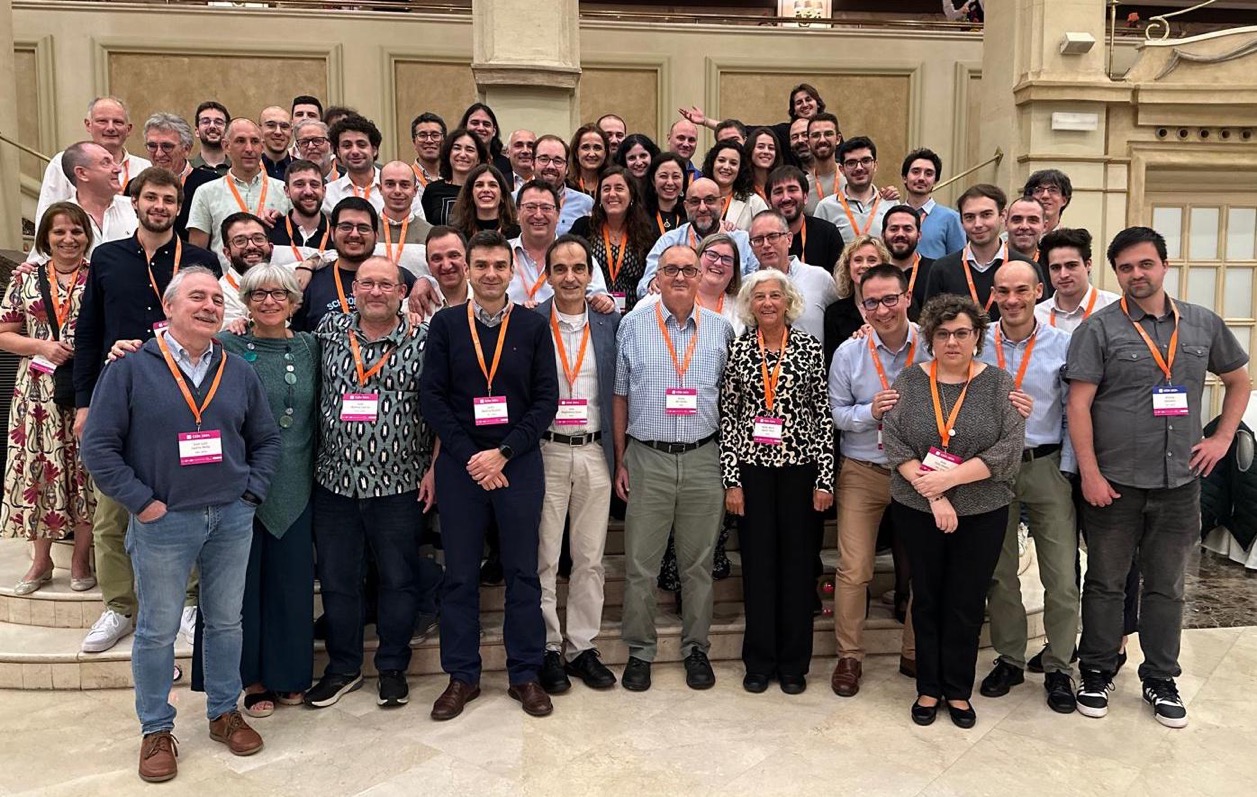
Our group presented three communications:
- F. Pérez-Gámez and C. Bejines. Álgebras de Heyting débiles: una generalización para retículos no distributivos.
- I.P. Cabrera, P. Cordero, E. Muñoz-Velasco and M. Ojeda-Hernández. Estructuras de clausura difusas como puntos fijos de conexiones de Galois.
- N. Madrid and M. Ojeda-Aciego. El f-índice de inclusión como par adjunto óptimo para modus ponens difuso.
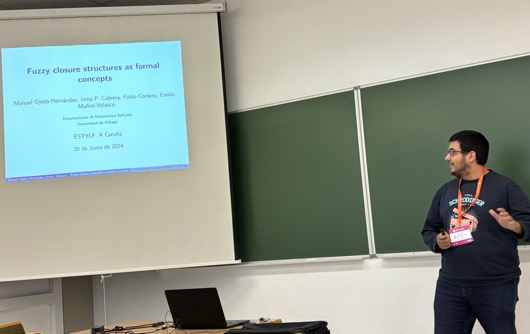
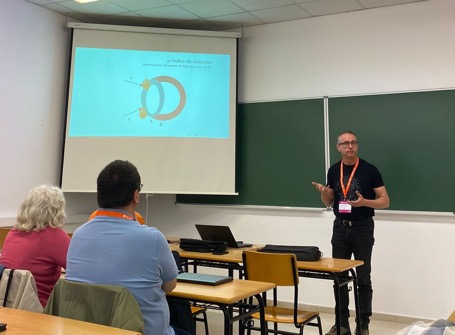
We also participated as co-editors of the proceedings of CAEPIA'24, published by Springer.
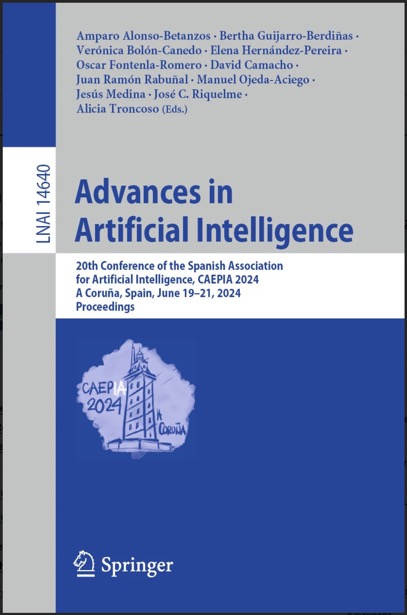
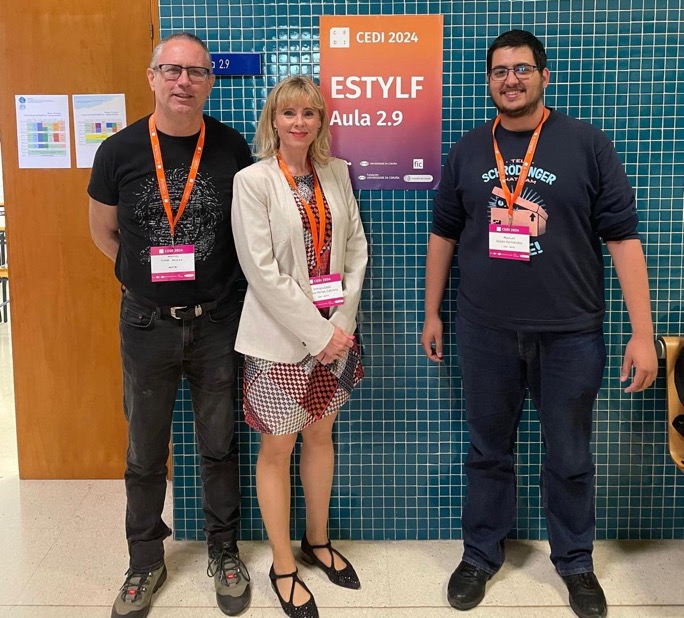
Conference papers accepted EUSFLAT
27/05/25/13:02 Filed in: Conference paper
N. Madrid, M. Ojeda-Aciego. Studying the structure generated by subsets of ƒ-indexes of inclusion.14th Conference of the European Society for Fuzzy Logic and Technology, Riga, 2025.
Key-Work Abstract The ƒ-index of inclusion has proven to be a suitable generalization of the inclusion in the fuzzy setting. In this paper, the properties of the ƒ-index of inclusion, when its definition is restricted to a subset of indexes, are analyzed. The theoretical results obtained in this work are necessary in order to develop fuzzy inference systems based on the ƒ-index of inclusion.
M. Holcapek, N. Cao, R. Valasek, N. Madrid, T. Tichy, D. Nedela. Weighted Quantile Approach to Time Series Forecasting Using Fuzzy-Probabilistic Inference Systems.14th Conference of the European Society for Fuzzy Logic and Technology, Riga, 2025.
Contributed Paper Abstract This talk introduces a novel time series forecasting method based on a fuzzy-probabilistic inference system. The central concept is the use of an IF–THEN rule system, where antecedents are represented by fuzzy sets forming a fuzzy partition of the time domain, and consequents are quantile functions that characterize the conditional distribution of time series values over each antecedent.
M. Ojeda-Hernández, D. López Rodríguez. On direct systems of implications with graded attributes. 14th Conference of the European Society for Fuzzy Logic and Technology, Riga, 2025.
Key-Work Abstract In this paper the problem of defining direct systems of implications in the fuzzy setting is studied. The directness of systems allows a quick computation of the closure operator in cases such as Fuzzy Formal Concept Analysis. Characterizing these properties in algebraic terms is deeply linked to Simplification Logic. After the theoretical results, some thoughts on algorithms to provide direct systems are also considered.
I.P. Cabrera, P. Cordero, B. De Baets, E. Muñoz-Velasco, M. Ojeda-Hernández. Kernel operators on trellises. 14th Conference of the European Society for Fuzzy Logic and Technology, Riga, 2025.
Contributed Paper Abstract In this work, we focus on interesting mathematical structures that are less known than lattices, namely the class of pseudo-ordered set, and in particular the subclass of trellises. We address the study of kernel operators and their counterparts, closure operators, within the general framework of pseudo-ordered sets and trellises. We also explore Galois connections which are intimately linked to those notions.
Key-Work Abstract The ƒ-index of inclusion has proven to be a suitable generalization of the inclusion in the fuzzy setting. In this paper, the properties of the ƒ-index of inclusion, when its definition is restricted to a subset of indexes, are analyzed. The theoretical results obtained in this work are necessary in order to develop fuzzy inference systems based on the ƒ-index of inclusion.
M. Holcapek, N. Cao, R. Valasek, N. Madrid, T. Tichy, D. Nedela. Weighted Quantile Approach to Time Series Forecasting Using Fuzzy-Probabilistic Inference Systems.14th Conference of the European Society for Fuzzy Logic and Technology, Riga, 2025.
Contributed Paper Abstract This talk introduces a novel time series forecasting method based on a fuzzy-probabilistic inference system. The central concept is the use of an IF–THEN rule system, where antecedents are represented by fuzzy sets forming a fuzzy partition of the time domain, and consequents are quantile functions that characterize the conditional distribution of time series values over each antecedent.
M. Ojeda-Hernández, D. López Rodríguez. On direct systems of implications with graded attributes. 14th Conference of the European Society for Fuzzy Logic and Technology, Riga, 2025.
Key-Work Abstract In this paper the problem of defining direct systems of implications in the fuzzy setting is studied. The directness of systems allows a quick computation of the closure operator in cases such as Fuzzy Formal Concept Analysis. Characterizing these properties in algebraic terms is deeply linked to Simplification Logic. After the theoretical results, some thoughts on algorithms to provide direct systems are also considered.
I.P. Cabrera, P. Cordero, B. De Baets, E. Muñoz-Velasco, M. Ojeda-Hernández. Kernel operators on trellises. 14th Conference of the European Society for Fuzzy Logic and Technology, Riga, 2025.
Contributed Paper Abstract In this work, we focus on interesting mathematical structures that are less known than lattices, namely the class of pseudo-ordered set, and in particular the subclass of trellises. We address the study of kernel operators and their counterparts, closure operators, within the general framework of pseudo-ordered sets and trellises. We also explore Galois connections which are intimately linked to those notions.
Journal paper accepted: Mathematics
13/02/24/10:27 Filed in: Journal paper
C. Bejines, M. Ojeda-Hernández, D. López-Rodríguez. Analysis of fuzzy vector spaces as an algebraic framework for flag codes. Mathematics. 2024
ABSTRACT Flag codes are a recent network coding strategy based on linear algebra. Fuzzy vector subspaces extend the notions of classical linear algebra. They can be seen as abstractions of flags to the point that several fuzzy vector subspaces can be identified to the same flag, which naturally induces an equivalence relation on the set of fuzzy vector subspaces. The main contributions of this work are the methodological abstraction of flags and flag codes in terms of fuzzy vector subspaces, as well as the generalisation of three distinct equivalence relations that originated from the fuzzy subgroup theory and study of their connection with flag codes, computing the number of equivalence classes in the discrete case, which represent the number of essentially distinct flags, and a comprehensive analysis of such relations and the properties of the corresponding quotient sets.
Journal papers accepted: IJAR, FSI
27/06/24/13:14 Filed in: Journal papers
F.J. Talavera, C. Bejines, S. Ardanza-Trevijano, J. Elorza. Aggregation of fuzzy graphs. Intl J of Approximate Reasoning 109243, 2024
ABSTRACT Our study is centered on the aggregation of fuzzy graphs, looking for conditions under which the aggregation process yields another fuzzy graph. We conduct an in-depth analysis of the preservation of several important properties and structures inherent to fuzzy graphs, like paths, cycles, or bridges. In addition we obtain appropriate criteria for when the aggregation of complete fuzzy graphs is again a complete fuzzy graph.
M. Ojeda-Hernández, D. López-Rodríguez, Á. Mora. A Formal Concept Analysis Approach to Hierarchical Description of Malware Threats. Forensic Science International, 2024. To appear.
ABSTRACT The problem of intelligent malware detection has become increasingly relevant in the industry, as there has been an explosion in the diversity of threats and attacks that affect not only small users, but also large organisations and governments. One of the problems in this field is the lack of homogenisation or standardisation in the nomenclature used by different antivirus programs for different malware threats. The lack of a clear definition of what a {category} is and how it relates to individual threats makes it difficult to share data and extract common information from multiple antivirus programs. Therefore, efforts to create a common naming convention and hierarchy for malware are important to improve collaboration and information sharing in this field.
Our approach uses as a tool the methods of Formal Concept Analysis (FCA) to model and attempt to solve this problem. FCA is an algebraic framework able to discover useful knowledge in the form of a concept lattice and implications relating to the detection and diagnosis of suspicious files and threats. The knowledge extracted using this mathematical tool illustrates how formal methods can help prevent new threats and attacks. We will show the results of applying the proposed methodology to the identification of hierarchical relationships between malware.
ABSTRACT Our study is centered on the aggregation of fuzzy graphs, looking for conditions under which the aggregation process yields another fuzzy graph. We conduct an in-depth analysis of the preservation of several important properties and structures inherent to fuzzy graphs, like paths, cycles, or bridges. In addition we obtain appropriate criteria for when the aggregation of complete fuzzy graphs is again a complete fuzzy graph.
M. Ojeda-Hernández, D. López-Rodríguez, Á. Mora. A Formal Concept Analysis Approach to Hierarchical Description of Malware Threats. Forensic Science International, 2024. To appear.
ABSTRACT The problem of intelligent malware detection has become increasingly relevant in the industry, as there has been an explosion in the diversity of threats and attacks that affect not only small users, but also large organisations and governments. One of the problems in this field is the lack of homogenisation or standardisation in the nomenclature used by different antivirus programs for different malware threats. The lack of a clear definition of what a {category} is and how it relates to individual threats makes it difficult to share data and extract common information from multiple antivirus programs. Therefore, efforts to create a common naming convention and hierarchy for malware are important to improve collaboration and information sharing in this field.
Our approach uses as a tool the methods of Formal Concept Analysis (FCA) to model and attempt to solve this problem. FCA is an algebraic framework able to discover useful knowledge in the form of a concept lattice and implications relating to the detection and diagnosis of suspicious files and threats. The knowledge extracted using this mathematical tool illustrates how formal methods can help prevent new threats and attacks. We will show the results of applying the proposed methodology to the identification of hierarchical relationships between malware.
Journal paper accepted: MMAS
05/02/25/13:34 Filed in: Journal paper
N. Madrid and M. Ojeda-Aciego. On the φ-index of inclusion: studying the structure generated by a subset of indexes. Mathematical Methods in the Applied Sciences, 2025.
ABSTRACT The φ-index of inclusion has proven to be a suitable generalization of the inclusion in the fuzzy setting. In this paper, the properties of the φ-index of inclusion, when its definition is restricted to a subset of indexes, are analyzed. The theoretical results obtained in this work are necessary in order to develop fuzzy inference systems based on the φ-index of inclusion.
ABSTRACT The φ-index of inclusion has proven to be a suitable generalization of the inclusion in the fuzzy setting. In this paper, the properties of the φ-index of inclusion, when its definition is restricted to a subset of indexes, are analyzed. The theoretical results obtained in this work are necessary in order to develop fuzzy inference systems based on the φ-index of inclusion.
Intl Seminar Participation
04/12/24/21:00 Filed in: seminar
M. Ojeda-Aciego. On the ƒ-index of inclusion: what is it? what is it good for? Seminar of AI of the Mathematical Institute of the Serbian Academy of Sciences and Arts .
We had the pleasure to participate at the Artificial Intelligence Seminar of the Mathematical Institute of the Serbian Academy of Sciences and Arts.
A number of interesting lines for further research were raised in the discussion following the presentation.
Thanks to Andreja Tepavcevic for the invitation.
ABSTRACT
The notion of inclusion is a cornerstone of set theory and therefore its generalisation in fuzzy set theory is of great interest. The functional degree (or φ-degree) of inclusion is defined to represent the degree of inclusion between two L-fuzzy sets in terms of a mapping that determines the minimal modifications required in one L-fuzzy set to be included in another in the sense of Zadeh. Thus, this notion differs from others existing in the literature because the φ-degree of inclusion is considered as a mapping instead of a value in the unit interval. We show that the φ-degree of inclusion satisfies versions of many common axioms usually required for inclusion measures in the literature.
Considering the relationship between fuzzy entropy and Young's axioms for measures of inclusion, we also present a measure of entropy based on the φ-degree of inclusion that is consistent with the axioms of De Luca and Termini. We then further study the properties of the φ-degree of inclusion and show that, given a fixed pair of fuzzy sets, their φ-degree of inclusion can be linked to a fuzzy conjunction that is part of an adjoint pair. We also show that when this pair is used as the underlying structure to provide a fuzzy interpretation of the modus ponens inference rule, it provides the maximum possible truth value in the conclusion among all those values obtained by fuzzy modus ponens using any other possible adjoint pair. Finally, we will focus on current work on the integration of the φ-degree of inclusion with FCA.
We had the pleasure to participate at the Artificial Intelligence Seminar of the Mathematical Institute of the Serbian Academy of Sciences and Arts.
A number of interesting lines for further research were raised in the discussion following the presentation.
Thanks to Andreja Tepavcevic for the invitation.
ABSTRACT
The notion of inclusion is a cornerstone of set theory and therefore its generalisation in fuzzy set theory is of great interest. The functional degree (or φ-degree) of inclusion is defined to represent the degree of inclusion between two L-fuzzy sets in terms of a mapping that determines the minimal modifications required in one L-fuzzy set to be included in another in the sense of Zadeh. Thus, this notion differs from others existing in the literature because the φ-degree of inclusion is considered as a mapping instead of a value in the unit interval. We show that the φ-degree of inclusion satisfies versions of many common axioms usually required for inclusion measures in the literature.
Considering the relationship between fuzzy entropy and Young's axioms for measures of inclusion, we also present a measure of entropy based on the φ-degree of inclusion that is consistent with the axioms of De Luca and Termini. We then further study the properties of the φ-degree of inclusion and show that, given a fixed pair of fuzzy sets, their φ-degree of inclusion can be linked to a fuzzy conjunction that is part of an adjoint pair. We also show that when this pair is used as the underlying structure to provide a fuzzy interpretation of the modus ponens inference rule, it provides the maximum possible truth value in the conclusion among all those values obtained by fuzzy modus ponens using any other possible adjoint pair. Finally, we will focus on current work on the integration of the φ-degree of inclusion with FCA.
Journal paper accepted: IJAR
25/02/25/10:31 Filed in: Journal paper
Francisco Pérez-Gámez, Carlos Bejines. An exploration of weak Heyting algebras: Characterization and properties. International Journal of Approximate Reasoning, 179: Article 109365, 2025.
ABSTRACT This paper explores weak Heyting algebras, an extension of complete Heyting algebras, focusing on characterizing this concept and identifying essential properties in terms of implication operators. The main emphasis is on unraveling the defining features and significance of the novel weak Heyting algebras. We further classify these structures within the context of a complete lattice and extend our findings to the Cartesian product. We facilitate comprehensive comparisons among these structures, by contributing to the broader understanding of weak Heyting algebras in mathematical research.
ABSTRACT This paper explores weak Heyting algebras, an extension of complete Heyting algebras, focusing on characterizing this concept and identifying essential properties in terms of implication operators. The main emphasis is on unraveling the defining features and significance of the novel weak Heyting algebras. We further classify these structures within the context of a complete lattice and extend our findings to the Cartesian product. We facilitate comprehensive comparisons among these structures, by contributing to the broader understanding of weak Heyting algebras in mathematical research.
Journal paper accepted MATHEMATICS
12/06/25/11:03 Filed in: Journal paper
C. Díaz-Montarroso, N. Madrid, E. Ramírez-Poussa. Correctness of Fuzzy Inference Systems Based on f-Inclusion. Mathematics 2025, 13, 1897.
ABSTRACT Recent work has shown that the f -index of inclusion can serve as a foundation for modeling Generalized Modus Ponens. In this paper, we develop a novel fuzzy inference system based on this inference rule. To establish its soundness, we connect it to a Fuzzy Description Logic LU enriched with fuzzy modifiers (also known as fuzzy hedges). This logic background provides to the approach a strength absent in most fuzzy inference systems in the literature, which allows us to formally prove a series of results that culminate in a final correctness theorem for the proposed fuzzy inference system. This paper also presents a running example aimed at showing the potential applicability of the proposal.
ABSTRACT Recent work has shown that the f -index of inclusion can serve as a foundation for modeling Generalized Modus Ponens. In this paper, we develop a novel fuzzy inference system based on this inference rule. To establish its soundness, we connect it to a Fuzzy Description Logic LU enriched with fuzzy modifiers (also known as fuzzy hedges). This logic background provides to the approach a strength absent in most fuzzy inference systems in the literature, which allows us to formally prove a series of results that culminate in a final correctness theorem for the proposed fuzzy inference system. This paper also presents a running example aimed at showing the potential applicability of the proposal.
Journal papers accepted FSS, COAM
28/11/25/10:00 Filed in: Journal papers
N. Madrid, M. Ojeda-Aciego. Composition as a fuzzy conjunction between indexes of inclusions. Fuzzy Sets and Systems, Article 109685, 2026.
ABSTRACT We analyze the use of the composition of mappings as a fuzzy conjunction between indexes of inclusion. Instead of the general approach of the φ-index of inclusion, we consider a fresh approach that computes the φ-index of inclusion when restricted to a join-subsemilattice of indexes of inclusion. Under this restriction, we identify a certain join-subsemilattice which has a biresiduated structure when composition is interpreted as conjunction. The main consequence of this biresiduated structure is a representation theorem of biresiduated lattices on the unit interval in terms of the composition and subsets of indexes of inclusion.
H. Bello, P. Jiménez, C. Bejines. Examining fuzzy number approximation through a topological algebraic approach. Computational and Applied Mathematics 45, 81 (2026).
ABSTRACT In this paper, we delve into the study of fuzzy number approximation by LR fuzzy numbers, shedding light on their algebraic properties. We present a solid approach to approximate fuzzy numbers keeping the same expected interval and core proving that such approximation is additive and continuous under a wide family of distances. As a key part of this construction, we study the set of fuzzy numbers as a topological monoid and develop a process to embed any cancellative abelian topological monoid with open shifts in a topological abelian group. This allows us to demonstrate a highly useful result in the context of this paper: the continuity of homomorphisms between cancellative topological abelian monoids with open shifts is equivalent to its continuity at zero.
D. López-Rodríguez, M. Ojeda-Hernández, A. Mora, C. Bejines. Close-by-One-like algorithms in the fuzzy setting: Theory and experimentation. Fuzzy Sets and Systems 520, Article 109574, 2025.
ABSTRACT In Fuzzy Formal Concept Analysis (FFCA), concept lattices are computed by scaling the problem and applying ordinary FCA algorithms. In this paper, the CbO family of algorithms is extended to work natively in the fuzzy setting, they are proved to be correct and output the whole set of formal concepts, which makes them mathematically equivalent to the scaling approach.
However, experimental results demonstrate the performance improvement of these methods compared to scaling. The paper also discusses a new fuzzy strategy based on blacklisting redundant truth values to enhance the performance of algorithms by taking advantage of the structure of the residuated lattice.
ABSTRACT We analyze the use of the composition of mappings as a fuzzy conjunction between indexes of inclusion. Instead of the general approach of the φ-index of inclusion, we consider a fresh approach that computes the φ-index of inclusion when restricted to a join-subsemilattice of indexes of inclusion. Under this restriction, we identify a certain join-subsemilattice which has a biresiduated structure when composition is interpreted as conjunction. The main consequence of this biresiduated structure is a representation theorem of biresiduated lattices on the unit interval in terms of the composition and subsets of indexes of inclusion.
H. Bello, P. Jiménez, C. Bejines. Examining fuzzy number approximation through a topological algebraic approach. Computational and Applied Mathematics 45, 81 (2026).
ABSTRACT In this paper, we delve into the study of fuzzy number approximation by LR fuzzy numbers, shedding light on their algebraic properties. We present a solid approach to approximate fuzzy numbers keeping the same expected interval and core proving that such approximation is additive and continuous under a wide family of distances. As a key part of this construction, we study the set of fuzzy numbers as a topological monoid and develop a process to embed any cancellative abelian topological monoid with open shifts in a topological abelian group. This allows us to demonstrate a highly useful result in the context of this paper: the continuity of homomorphisms between cancellative topological abelian monoids with open shifts is equivalent to its continuity at zero.
D. López-Rodríguez, M. Ojeda-Hernández, A. Mora, C. Bejines. Close-by-One-like algorithms in the fuzzy setting: Theory and experimentation. Fuzzy Sets and Systems 520, Article 109574, 2025.
ABSTRACT In Fuzzy Formal Concept Analysis (FFCA), concept lattices are computed by scaling the problem and applying ordinary FCA algorithms. In this paper, the CbO family of algorithms is extended to work natively in the fuzzy setting, they are proved to be correct and output the whole set of formal concepts, which makes them mathematically equivalent to the scaling approach.
However, experimental results demonstrate the performance improvement of these methods compared to scaling. The paper also discusses a new fuzzy strategy based on blacklisting redundant truth values to enhance the performance of algorithms by taking advantage of the structure of the residuated lattice.
Participation IPMU'24
24/07/24/11:48 Filed in: Conference participation
Intl. Conf. on Information Processing and Management of Uncertainty in Knowledge-based Systems, IPMU 2024
Our last event before the summer holidays was the IPMU conference, held in Lisbon, Portugal, where we could meet a number of colleagues and, particularly, our external collaborators Bernard De Baets, Irina Perfilieva and Marek Reformat (who incidentally was also the Program Chair of the conference).
The next steps on our research line on Galois connections were discussed with Bernard, and further work on fuzzy mathematical morphology and the F-transform was discussed with Irina. The details of a draft to be submitted for publication were also discussed with Marek.
Our group presented four papers in the conference
- Manuel Ojeda-Hernandez, Domingo López-Rodríguez, Francisco Pérez-Gámez and Carlos Bejines López. Quasi and pseudo-closed elements in partial formal concept analysis
- Manuel Ojeda-Hernandez, Inma P. Cabrera, Pablo Cordero and Emilio Muñoz-Velasco. Fuzzy pseudointents
- Nicolas Madrid and Eloisa Ramírez Poussa. Analysis of the f-index of inclusion restricted to a set of indexes
- Michal Holcapek, Nhung Cao, Radek Valasek, Nicolas Madrid, Tomas Tichy and David Nedela. An Exploration of The Weighted Quantile Approach in Probabilistic Fuzzy Inference

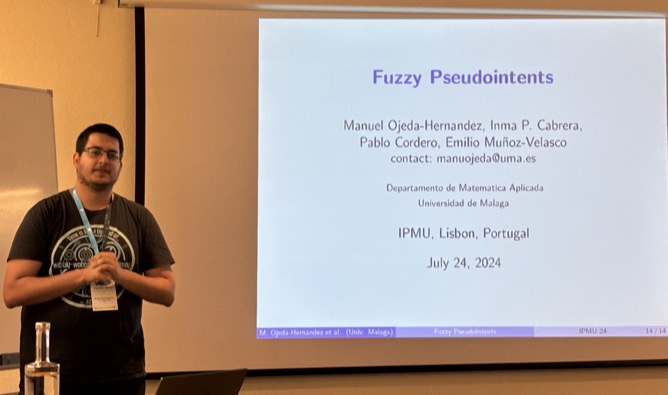
Participation WoFTU'24
12/02/24/13:00 Filed in: Workshop participation
Workshop on Formal Treatment of Uncertainty in Knowledge-Based Systems, Cádiz, February 8-11, 2024
This workshop is focused on creating synergies between academia, industry and third party partners to promote new challenges and projects in the framework of uncertainty in Artificial Intelligence.
We participated with two contributions and one tutorial:
Tutorial: Domingo López. fcaR, Formal Concept Analysis with R.
* Carlos Bejines: Aggregation Functions for uncertainty management.
* Domingo López: Concept lattice-based polarity analysis in texts.
* Manuel Ojeda-Aciego: f-inclusion for the design of deductive automatic systems.
Participation CONCEPTS'24
14/09/24/11:49 Filed in: Conference participation
International Joint Conference on Conceptual Knowledge Structures 2024
Just back from CONCEPTS'24, the first joint event of the three main conferences on Formal Concept Analysis, namely, ICFCA, CLA and ICCS.
This first edition was held in Cadiz, in the Aulario La Bomba, an old barracks that is now used as a conference centre and exhibition hall by the University of Cadiz.
Our research team participated with seven communications.
- Nicolás Madrid presented Towards a generalized modus ponens based on the φ-index of inclusion.
- Domingo López-Rodríguez presented Rearrangement of fuzzy formal contexts for reducing cost of algorithms.
- Our external collaborator Ondrej Krídlo presented Connecting concept lattices with bonds between L-fuzzy formal contexts by external information.
- Our colleague Inma P. Cabrera presented Fuzzy relational Galois connections between fuzzy transitive digraphs, joint work with Emilio Muñoz-Velasco, Manuel Ojeda-Aciego and others.
- M. Ojeda-Hernández presented Obtaining the necessary concepts in a partial formal context.
- Carlos Bejines presented Aggregation of fuzzy graphs.
- Our colleague Fran Valverde presented Progress in Formal Context Transforms, joint work with Manuel Ojeda-Aciego and others.

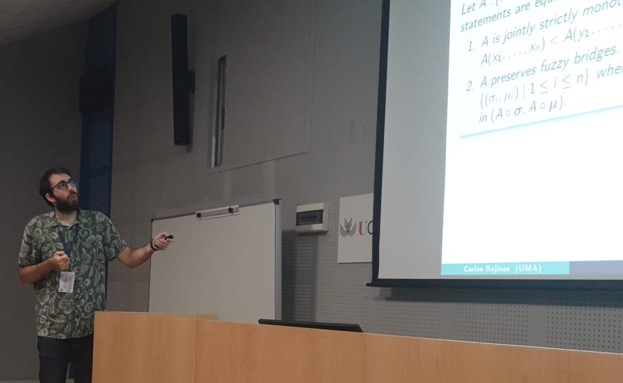
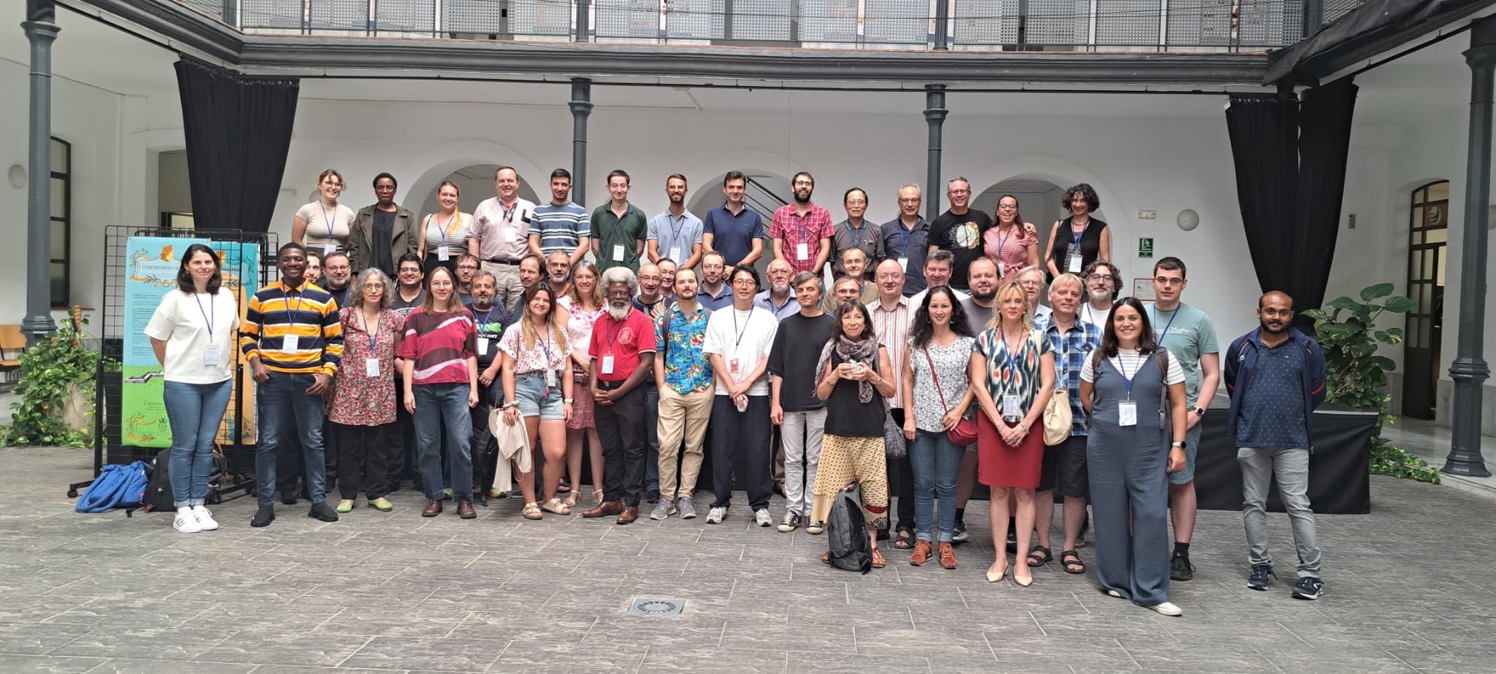
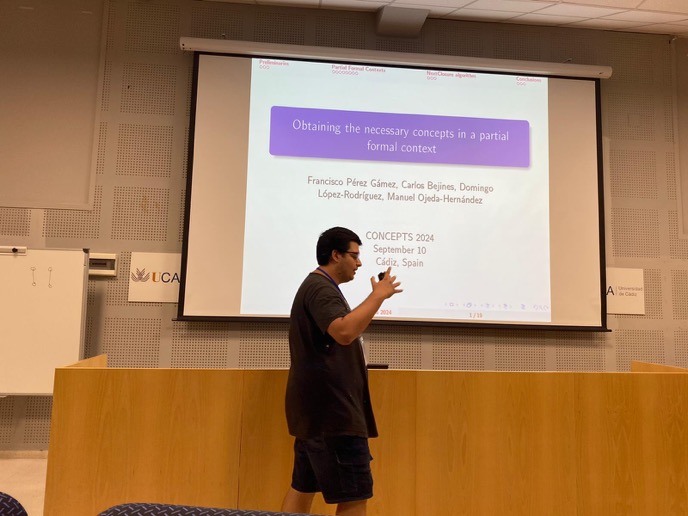
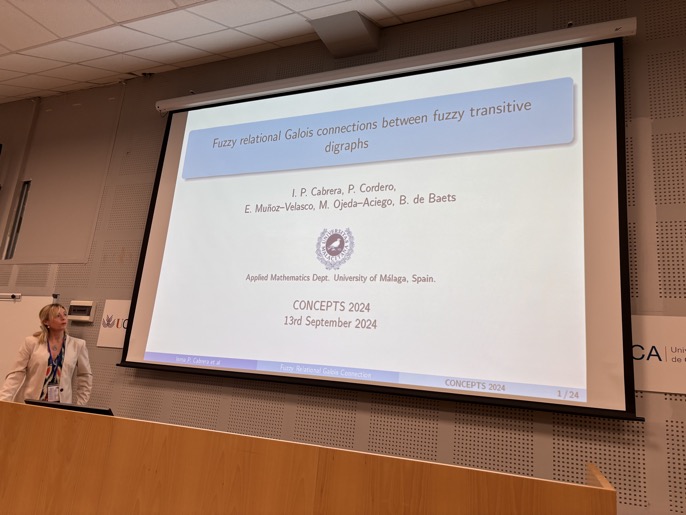
Participation ESCIM'25
26/05/25/11:21 Filed in: Conference participation
European Symposium on Computational Intelligence and Mathematics, ESCIM, Coruña, Spain, May 18-21, 2025
A well-attended conference in which our team presented two keyworks and one position paper. The titles of the talks were "Composition as a fuzzy conjunction between indexes of inclusion", "New simplification rules for databases with positive and negative attributes" and "Unfiltered Large Language Models: Forensic and Legal Challenges of their Criminal Use on the Dark Web: a preliminary study".
We had the opportunity to meet again a number of colleagues, Vilém Novák, Vladik Kreinovich, László Koczy, Francesc Esteva, Juan Moreno, and Jesús Medina among others, in order to discuss prospects of future work or continue the existing ones. In the picture, our team members and after de gala dinner with Irina Perfilieva (external member) and Vilém Novák.
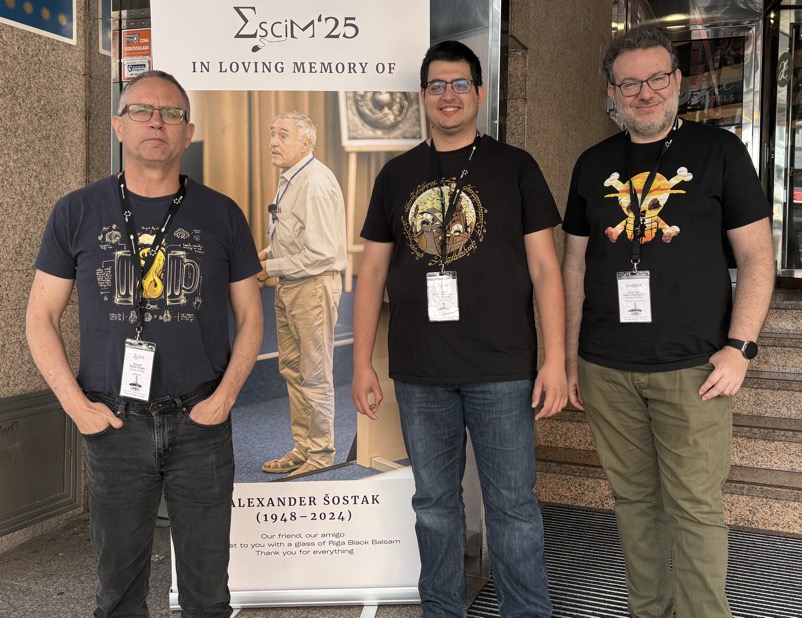
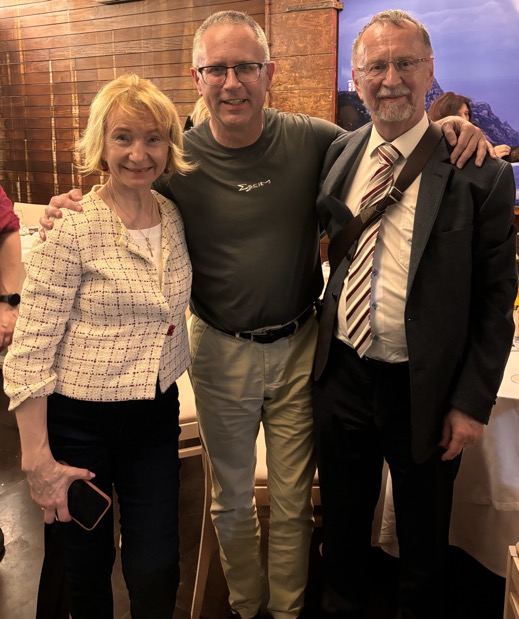
Conference papers accepted ESTYLF
17/04/24/10:15 Filed in: Conference papers
Francisco Pérez-Gámez and Carlos Bejines. Álgebras de Heyting débiles: una generalización para retículos no distributivos. Congreso Español de Tecnología y Lógica Difusa (ESTYLF), Coruña, 2024.
ABSTRACT En este artículo se presentan las álgebras de Heyting débiles. Estas álgebras constituyen una extensión del álgebra de Heyting adaptada a retículos no distributivos. Fijado un retículo, se enumeran condiciones que garantizan la existencia de estas álgebras. Además, se caracterizan en función de los operadores de implicación y se acota su rango.
I.P. Cabrera, P. Cordero, E. Muñoz-Velasco and M. Ojeda-Hernández. Estructuras de clausura difusas como puntos fijos de conexiones de Galois. Congreso Español de Tecnología y Lógica Difusa (ESTYLF), Coruña, 2024.
ABSTRACT Las conexiones de Galois parecen estar omnipresentes en las matemáticas. Se han utilizado para modelizar soluciones de problemas tanto puros como orientados a aplicaciones. A lo largo del artículo, el marco general es un retículo completo difuso sobre un retículo residuado completo. En este trabajo, se estudia la existencia de conexiones difusas de Galois (antítonas e isótonas) entre cuatro conjuntos ordenados específicos. Lo más interesante es que los sistemas de cierre difusos, los operadores de cierre difusos y las relaciones de cierre difusas fuertes son conceptos formales (puntos fijos) de estas conexiones de Galois difusas..
N. Madrid and M. Ojeda-Aciego. El f-índice de inclusión como par adjunto óptimo para modus ponens difuso. Congreso Español de Tecnología y Lógica Difusa (ESTYLF), Coruña, 2024.
ABSTRACT Continuamos estudiando las propiedades del f-índice de inclusión y mostramos que, dado un par fijo de conjuntos difusos, su f-índice de inclusión puede vincularse a una conjunción difusa que forma parte de un par adjunto. También mostramos que, cuando este par se utiliza como estructura subyacente para proporcionar una interpretación difusa de la regla de inferencia modus ponens, proporciona el máximo valor de verdad posible en la conclusión entre todos los valores obtenidos por modus ponens difuso utilizando cualquier otro par adjunto posible.
ABSTRACT En este artículo se presentan las álgebras de Heyting débiles. Estas álgebras constituyen una extensión del álgebra de Heyting adaptada a retículos no distributivos. Fijado un retículo, se enumeran condiciones que garantizan la existencia de estas álgebras. Además, se caracterizan en función de los operadores de implicación y se acota su rango.
I.P. Cabrera, P. Cordero, E. Muñoz-Velasco and M. Ojeda-Hernández. Estructuras de clausura difusas como puntos fijos de conexiones de Galois. Congreso Español de Tecnología y Lógica Difusa (ESTYLF), Coruña, 2024.
ABSTRACT Las conexiones de Galois parecen estar omnipresentes en las matemáticas. Se han utilizado para modelizar soluciones de problemas tanto puros como orientados a aplicaciones. A lo largo del artículo, el marco general es un retículo completo difuso sobre un retículo residuado completo. En este trabajo, se estudia la existencia de conexiones difusas de Galois (antítonas e isótonas) entre cuatro conjuntos ordenados específicos. Lo más interesante es que los sistemas de cierre difusos, los operadores de cierre difusos y las relaciones de cierre difusas fuertes son conceptos formales (puntos fijos) de estas conexiones de Galois difusas..
N. Madrid and M. Ojeda-Aciego. El f-índice de inclusión como par adjunto óptimo para modus ponens difuso. Congreso Español de Tecnología y Lógica Difusa (ESTYLF), Coruña, 2024.
ABSTRACT Continuamos estudiando las propiedades del f-índice de inclusión y mostramos que, dado un par fijo de conjuntos difusos, su f-índice de inclusión puede vincularse a una conjunción difusa que forma parte de un par adjunto. También mostramos que, cuando este par se utiliza como estructura subyacente para proporcionar una interpretación difusa de la regla de inferencia modus ponens, proporciona el máximo valor de verdad posible en la conclusión entre todos los valores obtenidos por modus ponens difuso utilizando cualquier otro par adjunto posible.
Conference paper accepted FUZZ-IEEE
17/03/24/10:18 Filed in: Conference paper
D. López-Rodríguez and M. Ojeda-Hernández. Enhancing performance of FCA algorithms via rearrangement of formal contexts. Intl Conf on Fuzzy Systems (FUZZ-IEEE), Yokohama, Japan, 2024.
ABSTRACT In this paper, the effect of reordering the attributes prior to computing the concept lattice in formal contexts is explored. Several criteria are given in order to choose an ordering and then some experimental results are provided, first comparing the state-of-the-art algorithms in the crisp case and then examining the results of reordering the attributes in fuzzy formal contexts..
ABSTRACT In this paper, the effect of reordering the attributes prior to computing the concept lattice in formal contexts is explored. Several criteria are given in order to choose an ordering and then some experimental results are provided, first comparing the state-of-the-art algorithms in the crisp case and then examining the results of reordering the attributes in fuzzy formal contexts..
